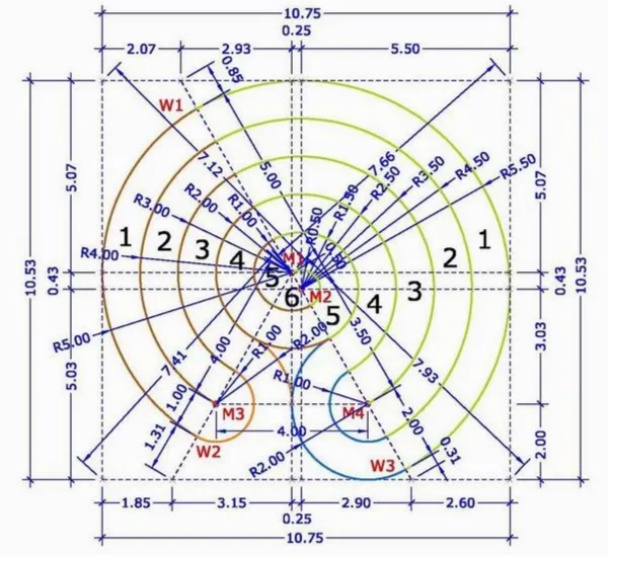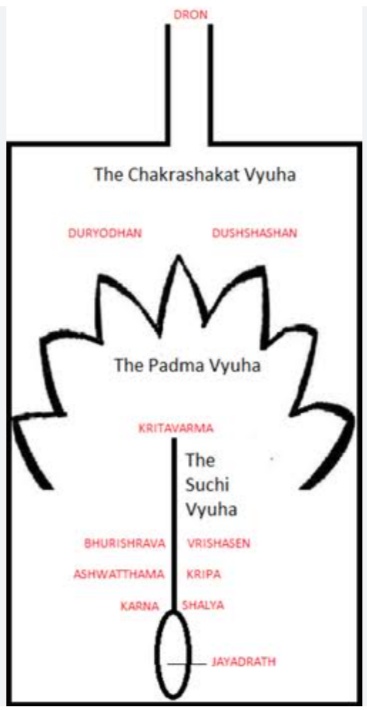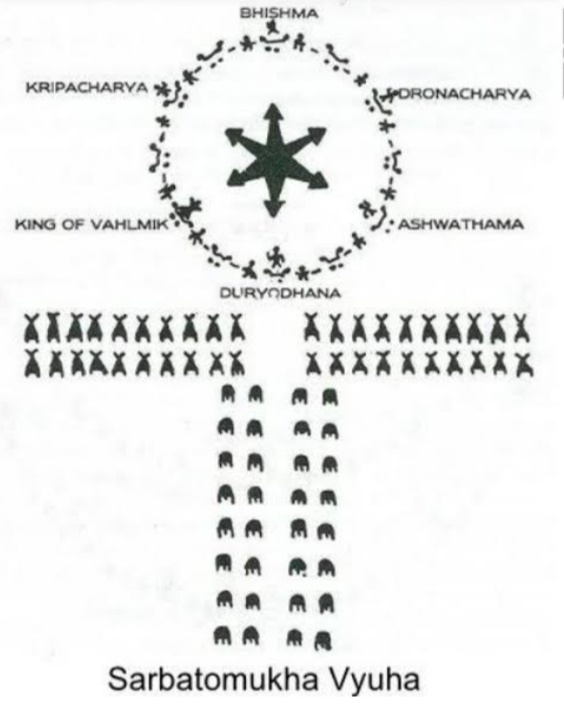Bhārat has been the land of wars for Dharma that was always based on Dharmic regulations.
The sena / bala or the army was one of the most essential constituents of any state. Shukryacharya defined the sena/bala as an organized group of men well provided with offensive and defensive weapons. For the proper conduct of war armies were organized into various classes, arms, and units. Commanders were appointed to lead the army on the battlefield, which was supported by a coordinated logistics system in order to meet the necessary requirements.
This system which was prevalent in ancient India was a crude form of Military Science and the Science of warfare, as time went on it got evolved.
The military was composed of four arms (chaturanga)—infantry, cavalry, chariots, and elephants. They were all deployed in the field of battle in formation (vyuha), as decided by the commanders, based on factors such as the nature of the terrain and the composition of one’s and one’s enemy’s forces. Great concern was shown for the training of men and animals. The kings and princes were well-trained in the arts of war and leadership, personally led armies, and participated in the defense of forts.
One such magnificent war full of pompous splendor & psychological maneuvers was the Mahābhārat war or Kurukshetra war. The Mahābhārata war was fought over eighteen days. It is broken down into five phases: (1) Bhishma Parva : from Day 1 to Day 10, (2) Drona Parva : from Day 11 to Day 15, (3) Karna Parva : on Days 16 and 17, (4) Shalya Parva : on Day 18, and (5) Sauptika Parva, on the eighteenth night when Ashwatthama raids the Panchala camp.
WHAT IS A VYUHA?
Vyūha (Sanskrit: व्यूह) means – ‘to arrange troops in a battle array (formation)’, ‘to arrange, put or place in order, to dispose of, separate, divide, alter, transpose, disarrange, resolve. Its root is व्यः which means – a ‘cover’ or ‘veil’. Vyuha is not a static position wherein the army would simply arrange the soldiers and generals in that formation and go attack the enemy. A Vyuha is dynamic in nature and it continuously adapts itself to the position and situation of the war.
Of the many spectacular arrays that were displayed & employed by Duryodhana’s ekadash akshauhini sena & Yuddhisthir’s sapta akshauhini sena, only Chakravyuh is well known in which Abhimanyu was trapped never to emerge alive. Let us dive into other vyuhas that were employed on occasions by the stakeholders. Often Vyuha displayed by one flank was counter of the other. Some of these were defensive while other were offensive.
SYENA VYUHA
The Syena Vyuha was only used once, by the Pandavas on Day 5. It is the shape of a hawk, not to be confused with the Garuda Vyuha which is shaped like an eagle. Also, while the Syena is just any other hawk, the Garuda Vyuha is not about any other eagle. It is the specific eagle Garuda that the formation mimics. So it appears that the Syena Vyuha does not have quite the same pedigree as the Garuda.
Bhimasena got the beak, Shikhandi and Dhrishtadyumna became the eyes, and Satyaki led the division that formed the bird’s eyes. Arjuna was on the neck.
SHAKAT VYUHA (Cart/Box formation)
Shakata vyuha is an array in which the army is drawn up in a narrow and compact order and its rear expands in extended columns like the back of an Indian cart. Drona used this formation on the 11th day for the Kauravas.
ASURA VYUHA & DEVA VYUHA
On the tenth day Kauravas army chose, Asura Vyuha and the Pandavas countered it by arranging their army in Deva Vyuha. In the lead was Shikandhi with Bhima and Arjuna to protect his sides. Behind him were Abhimanyu and the children of Draupadi. Satyaki and Dhristadhyuma were with them. Virata and Drupada had two charges over the rest of the army. Kekayu brothers, Dhristaketu and Gatotkacha were in their ranks. The Pandavas had the single-pointed aim to kill Bhishma and were successful in the same.
SARVATOBHADRA VYUHA & NAKSHATRAMANDAL VYUHA
On the ninth day, Bhishma made use of a Vyuha called Sarvatobhadra Vyuha which meant safe from all sides. Bhishma was in the front, Guarded by Kripa, Kritaverma, Shakuni, Jayadratha, Kamboja and sons of Dhritarastra. Trigartas were also there. The Pandavas formed a Vyuha called Nakshatramandal vyuha in the shape of a constellation. The Pandavas and sons of Draupadi were leading from the front. Shikhandi Chekitan and Ghatotkacha were holding important positions to defend. Abhimanyu, Kekaya brothers, and Drupada were guarding the rear.
SUCHIMUKHA VYUHA (Needle formation)
The Suchimukha Vyuha was not used as a stand-alone vyuha in the Kurukshetra war. But on the 14th day of the war, Drona created a complex triple-layered formation called Chakrashatak Vyuha. First was the Chakravyuha where he was standing guard himself. That Vyuha opened into the second Sakatavyuha the charge of which was in the hands of Duramarshana, the brave brother of Duryodhana. At the third tier was the Soochimukha Vyuh with Karna, Bhurishrava, Ashvatthama, Salya, Vrishasena, Kripa to guard it and Jayadratha was at the very end of the Vyuha.
CHAKRA VYUHA
The Chakravyuha, is a multi-folding defensive formation that looks like a disc (chakra, चक्र) when viewed from above. The warriors at each interleaving position would be in an increasingly tough position to fight.
As per this military strategy, a specific stationary object or a moving object or person can be captured and surrounded and rendered fully secured during times of military conflict. The pattern is of two soldiers on both sides with other soldiers following them at a distance of three hands, drawing up seven circles and culminating at the end which is the place where the captured person or object is to be kept. In order to make Chakravyuha, the Commander has to identify soldiers who will form this formation. The number of soldiers to be deployed and the size of the Chakravyuha is calculated as per the resistance estimated. Once drawn, the foremost soldiers come on either side of the component to be captured, engage briefly and then move ahead. Their place is taken up by the next soldiers on either side, who again engage the component briefly and then move ahead. In this fashion, a number of soldiers keep on passing the component and keep on moving in a circular pattern. By the time the last bit of soldiers arrives, the component, oblivious of the design is captured within seven tiers of soldier formation surrounding him from all sides. The last soldiers of the formation give the signal of completing the Chakravyuha. On the signal, every soldier who so far has been facing outwards turns inwards to face the component. It is only then that the captured component realizes his captivity. The Chakravyuha keeps on moving in a spherical order and can easily lead the component away in captivity as well. The formation of Chakravyuha is never visible from the ground. But anyone from above can easily decipher the movement. It is a hopeless no escape situation for the captive. This strategy was applied during prehistoric days. The component even if heavily guarded, cannot escape the web of a chakravyuha.

The formation was used in the battle of Kurukshetra by Dronacharya, who became commander-in-chief of the Kaurava army after the fall of Bhishma. It is the most renowned among the different formations used in the Mahabharata war, simply because this was part of the turning point in the war. Drona made the Chakravyuha with 6 layers under the guard of 6 Maharathis – Karna, Drona, Ashwatthama, Dushasana, Shalya, and Kripacharya. Duryodhana was positioned at the center with different warriors at the various layers. Jayadratha and his army were at the gate of this vyuha.
PADMA VYUHA (Blooming Lotus Formation)
The Padma Vyuha is often confused with the Chakravyuha. There is a considerable difference between these formations though there are many similarities as well. Similar to Chakra-Vyuha, this is also a multi-folding defensive formation in the form of a blooming lotus when viewed from above. Again only a handful of warriors knew the technique of breaching this formation.

KRAUNCH VYUHA
Military formation on a pattern supposed to resemble a heron with an outstretched beak and spreading wings. Krauncha vyuha, a very offensive formation, was generally attempted to induce fear in the opponent army. Pandava army was arranged in this vyuha on the second day of the Mahabharata war. Drupada was at the head and Kuntibhoja was placed at the eye. The army of the satyaki formed the neck of the Kauncha bird. Bhima and Dhristadhymna formed both wings of the Vyuha. The sons of Draupadi and Satyaki were to guard the wings. The formation of the army phalanxes in this manner was very formidable.
The Krauncha Vyuha was also arranged by Bhishma. Bhurishrava and Salya were to guard the wings. Somdatta, Ashwatthama, Kripa, and Kritavarma were positioned at different important places in the formation.
GARUDA VYUHA
The Heron Formation (Krauncha Vyuha) was usually met with Garuda or eagle Formation. Eagle is a Natural Enemy of Heron. The Swoop of the Garuda, nullifies and swamps the posture of the Heron. In its form, the Garuda Vyuha resembles the Krauncha vyuha, with a subtle difference in that it resembles an eagle. On the second day Bhishma arranged his army in Garuda vyuha to counter the Krauncha vyuha of the Pandavas. Bhishma himself got positioned at its beak. Drona and Kritavarna were the eyes. Kripa and Ashvatthama were at the head. The Trigartas and the Jayadratha with their armies made the neck. Duryodhana, and his brothers, Vinda and Anuvinda made the body of the formation whereas the King of Kashala, Brihadbala formed the tail of the formation.
SARVATOMUKHI DAND VYUHA
This was the formation used by Bhishma on the 1st day of the Kurukshetra war. The head of the formation had 6 Maharathis arranged in a circular form and the rear end is shaped like a rod (Dand) to keep resourcing the head.

OTHER CRUCIAL VYUHAS
•Mandala Vyuha (Galaxy formation)
It was a defensive circular formation very difficult to penetrate. The Commander-in-chief, situated at the centre of the formation, usually leads the army and is surrounded by several small groups of soldiers, each group led by a Maharathi. On the seventh day of the war, Bhishma made Mandala Vyuha. The Pandavas countered it with Vajra Vyuha.
•Vajra Vyuha ( Diamond or Thunderbolt Formation): Pandavas chose Vajra Vyuha to counter Mandala Vyuha formation on the 7th day. This formation was also used by the Pandavas on the first day of the war. In this formation, all maha-rathis are situated at the centre of the squared formation and are surrounded by infantry from all sides. Drishtadhyumna lead the formation and was followed by the five Pandavas on the 7th day. And it was Bhima who lead the formation on the first day.
•Kurma Vyuha (Turtle formation) and Trishula Vyuha (Trident formation)
The Kurmavyuha was formed by Bhishma on the 8th day of the war. The Pandavas countered it with the Trishula vyuha.
•Oormi Vyuha (Ocean formation)
On the afternoon of the 8th day, Bhishma changed his formation to Oormi Vyuha. In this formation, the army is arranged on either side like the waves of the sea.
•Sringataka Vyuha : Dhrishtadyumna chose this as the counter-array for Bhishma’s Oormi Vyuha. A sringataka is a horn that seeks to maximize depth while sacrificing breadth.
This seems like a logical array to use against something like an Oormi, but of course, the horn must choose its piercing point carefully. Because otherwise the wave can collapse all around it and swallow it whole.
Since the horn has only one tip, it becomes all-important to load it with your best warriors.Arjuna, Bhimasena, and Satyaki – three of the Pandavas’ best – fought at the tip of the Sringataka that morning, with Yudhishthir concealed out of sight in the middle of the array, flanked by Nakula and Sahadeva.
•Makara Vyuha (Crocodile formation)
On the fifth day of the war, Bhishma chose to arrange his army in Makarvyuha. Arjuna, Yudhisthira, and Dhristadhyumna decided on the Hawk formation of their Army. All the warriors of both sides were assigned to specific places in the formations with special responsibilities.
On the sixth day, it was the Pandavas who preferred the Makara Vyuha. The Kauravas chose Krauncha Vyuha. On this day Bhima was coming in and out of the Vyuha of the Kauravas, killing soldiers at will, swinging his terrible mace.
•Ardha Chandra/Chandrakala Vyuha (Half crescent formation)
Arjuna arranged this formation in consultation with the commander of the Pandava army Dhristadhyumna on the 12th day of the war. his arrangement. At the right end was the powerful Bhima. Abimanyu was at the left end. Ghatotkacha and Kokaya brothers were at the left rear. Satyaki and the five sons of Draupadi were at the rear centre. Yudhisthira was placed at the centre of the formation. The armies of Drupada and Virata led from the front guarding Yudhistira. Neel and Dhristadhymna were placed next to them with Dhristaketu and Shikandi following at the rear end. At the tip was Arjuna at his Chariot with Krishna.
•Mala Vyuha or a ‘garland formation’ which was presumably ring-shaped.
SOURCES
1.”A shrine of Aniruddha, the fourth of the ‘vyuhas’ Journal of the Indian Society of Oriental Art.1937. p. 16.
2. Science of Chakravyuh Rajiv Ranjan Prasad
3.hi.krishnakosh.org
4. Mahābhārat Dronaparva
Featured image sourced from internet.
![]()
- BHĀRAT: EVOLUTION OF A DYNAMIC & DIVINE RĀSHTRA - September 12, 2023
- ECHOES OF INDIC FACETS EMBEDDED IN JAPANESE CULTURE - July 7, 2023
- YOGINIS: SACRED FEMININE DIVINITY & ENLIGHTENMENT - May 25, 2023

